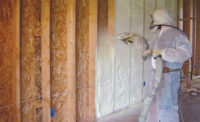Energy efficiency, durability, resiliency and a healthier indoor environment, are all key goals when optimizing the enclosure. One key focus required to achieve a high-performance building commercial building envelope air leakage database (which contains information for almost 400 buildings including 70 constructed over the 2004-2014 period), the institute found that the 79 buildings in the database constructed with an air barrier had an average air leakage almost 70 percent less than the average for the 290 buildings in the database not specified as having one. With uncontrolled air leakage being a known cause of energy loss and increased energy cost, the review demonstrates the critical need to design and construct with an air barrier to enhance airtightness and to support sustainability and energy efficiency in commercial structures.
When looking to achieve airtightness in commercial buildings, the goal is to limit the uncontrolled leakage of conditioned air, as well as to limit the infiltration of unconditioned air into the facility. In addition to negatively affecting the energy efficiency of the structure, unconditioned air entering the structure may also introduce pollutants, allergens and moisture in the interior, which can result in a host of health concerns including microbial growth and other asthma triggers. Effectively sealing air leakage points in the envelope will thus not only dramatically reduce energy consumption and long-term energy costs, but it will also reduce health risks for occupants.
Identifying Common Air Leakage Locations
A properly constructed high performance building will follow the mantra: Build it tight and ventilate it right. This concept includes HVAC systems that will mechanically control and filter air changes with the exterior to help control the quality of interior air. Random air leaks through a wall or roof in an improperly insulated envelope will not control the quality or volume of air being exchanged. A controlled supply of exterior air is needed to appropriately dilute stale interior air which, over time, can contain air born germs that might be produced by building occupants, elevated levels of perfumes, smells or even to help with humidity control. A tight building will have a HVAC system that monitors for these factors, along with many others and will exchange air as needed in a controlled manner.
Uncontrolled air leakage may occur in a number of locations in the building envelope. The pressure differentials between the exterior and interior will pull air through a wall without a proper air barrier by way of entry points that may occur on either the interior or the exterior of the walls. One of these common pathways is the structure’s change of planes, or points where the structure shifts directions, such as right angles. Pathways may also occur where exterior sheathing is not properly installed or treated after penetrations, leading to compromises in the building envelope. Additionally, any type of interior penetration may act as a pathway. Light switches, electrical outlets, and interior décor hung with nails all apply.
Spray Foam Insulation as Air, Thermal and Moisture Barrier
One high-performance envelope solution for air leakage is medium-density, closed-cell spray polyurethane foam insulation, which performs remarkably well as a single-source solution for thermal, air, vapor and water control. As a thermal insulator, SPF boasts one of the highest R-values per inch of all insulation options available. Because the material forms in-place and fully adheres, it virtually eliminates cracks and gaps that leak air or water. It can also be applied in a continuous layer, eliminating most thermal bypasses.
The thermal performance and air-sealing from SPF lowers energy costs for the building over the lifespan of the building. Closed-cell SPF also provides structural enhancement and qualifies as both a vapor retarder and water resistive barrier*. It may be applied on the interior of walls, as well as along exterior walls as continuous insulation. Low-density, open-cell SPF is also an air barrier material and may be used inside of the walls stud cavity. While not a WRB or vapor retarder, open-cell foam expands inside of the wall to adhere to the surfaces creating a strong air barrier internally.
When the building envelope incorporates alternate forms of insulation, such as air permeable fiberglass or cellulose, openings caused by wall penetrations allow air to flow and transfer through the insulation. However, with either closed or open-cell SPF the insulation surrounds penetrations, seals and forms an effective air barrier, dramatically reducing air leakage. A spray foam air barrier is no longer a thin layer and small, after the fact, partial penetrations like the head of a nail, will not compromise the air barrier performance.
Seal the Structure Properly, Reduce Occupant Health Risks
Sealing the structure and eliminating air leakage points in the envelope is of paramount importance in creating a healthier indoor environment. Without an effective air barrier and seal, the building may put the health of occupants at risk. Major concerns SPF protects against are the health risks associated with unmanaged moisture and poor air quality.
ASHRAE, in its Position Document on Limiting Indoor Mold and Dampness in Buildings, notes that, in buildings, “as moisture levels increase, so does the possibility of microbial growth and with it the potential for adverse effects on the building and its occupants.” The report also asserts that in both North America and Europe, building dampness and mold have been documented to be associated with adverse health outcomes related to asthma and upper respiratory problems. ASHRAE points out in its report that the exterior enclosure is one of the most common points of entry and that well-designed and constructed building envelopes are critical to the prevention and control of excess moisture and microbial growth because they limit thermal bridges and the entry of liquid water, humid air or water vapor diffusion.
When looking at the effects of air quality in a commercial structure, the American Lung Association also proves useful. The ALA State of the Air 2019 report asserts that ozone and short-term particle pollution has worsened in many U.S. cities between 2015 and 2017, compared to between 2014 and 2016. The report also links asthma directly with both ozone and particle pollution. Asthma triggers present in the daily environment include pollen, smoke, pet dander, dust, mold, ozone, chemicals and changes in the weather. Asthma triggers affect those with respiratory sensitivity when they are exposed to these uncontrolled particulates.
Risk of dangerous asthma attacks increases for building occupants when particle pollution infiltrates the structure, something that occurs when the envelope lacks a proper seal, such as when air leakage is occurring.
One common way to prevent particle pollution infiltration is through high performance building products that create airtightness, such as spray foam insulation. Because asthma triggers include mold, mildew and dramatic temperature changes, an ideal seal will act as a barrier and effective moisture, thermal and air control solution. Spray polyurethane foam insulation uniquely provides all of these functions and its resulting airtightness controls indoor humidity, reducing the likelihood of mold and mildew triggers, while its thermal control capabilities reduce asthma inducing hot and cold pockets. The material also reduces dust, pollen, airborne chemicals, exhaust (from vehicles exiting and entering attached garages) and other asthma triggers from entering the building.
Additional Points of Possible Leakage
While closed-cell spray polyurethane foam insulation is a material innovation with the unique ability to provide air, thermal, vapor and water control, there will inevitably be places in the envelope that it cannot address. These key areas include doors and windows, which all must be properly sealed around their perimeters to prevent additional points of air leakage. Doors and windows should also close properly to reduce air leakage risk.
In properly addressing air leakage and in sealing the commercial envelope with insulation that acts as air, thermal, vapor and water barrier, the structure will inevitably consume less energy, lower energy costs and provide a healthier environment for all those who occupy it. W&C
* Material/system test performed for building code. It determines the SPF’s ability to prevent liquid rain water from entering the building.






Report Abusive Comment